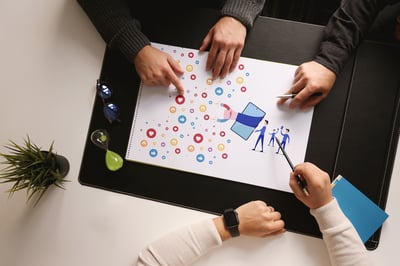July 2, 2025
 by Michael Brenner / July 2, 2025
by Michael Brenner / July 2, 2025
“Great products don’t sell themselves — great branding makes people want to know more the moment they see it.”
Branding today goes beyond logos and aesthetics; it's about sparking curiosity and connection the moment your audience discovers you. And that’s where brand activation begins.
Exhibiting your brand with the right messaging and design is the cornerstone of brand activation, which can set the playing field for marketing success. Unless you have trusted product validation, you cannot invest in brand activation.
Building proper referral marketing channels in the R&D stage of your product marketing with customer advocacy software is the right way to launch your value proposition and earn trust through brand activation. Let's examine this in detail.
Brand activation is a marketing strategy that drives consumer action through brand interaction and engagement. It builds awareness, strengthens customer relationships, and encourages loyalty by creating memorable, real-world experiences that connect the brand directly with its target audience.
While brand activation might seem like flashy marketing on the surface, it’s really about building structured, intentional experiences that drive connection.
It is a way for a brand to identify its real people, land its product, and derive intent for its marketing to prevent unprecedented outcomes and achieve profitable business.
You need strong content, credible mentorship, and real-world success stories that create emotional resonance and lasting brand recall. Once you have deliverables, craft a promotional strategy while encircling the informational value of your brand.
In a nutshell, brand activation includes a product marketing strategy to interact with your target group across online and offline channels to create a buzz for your brand in the early stages.
Your brand is your culture. Your entire company shapes the emotional connection you are striving for with customers. Brand activation needs to be something the whole company takes on, not just the marketing department.
In a competitive market, brand activation can offer ways to attract customers that your competitors do not. It's a chance to be unique and create meaningful interaction. The more you connect with customers, the more likely they will become loyal. Brand loyalty speaks volumes about your value proposition and consumer experience strategy.
There are many ways to build brand awareness, but brand activation generates an emotional attachment. Being aware of your brand won't drive action to become a customer. They must relate to your brand, core message, and solutions to trust you. Consistent value and trust-building help brands thrive, even in highly competitive markets.
Now that you understand what brand activation is and why it matters, let’s look at real-world examples that brought it to life.
Brand activation can take the form of anything, like guerrilla marketing or immersive experiences.
Still, there is a common thread throughout these brand activation examples: thinking outside the box. Use the following examples to encourage new advertising techniques at your business, whether your focus is B2C, D2C, or B2B marketing.
Bala Bangles made waves when founders Natalie Holloway and Max Kislevitz stepped onto the Shark Tank stage in 2021, determined to reimagine the workout accessory market. Their pitch? Stylish, wearable weights designed to integrate seamlessly into everyday movement, whether during yoga, walking, or multitasking around the house.
To break through a saturated fitness industry, Bala leaned into visual storytelling and lifestyle branding, pairing their sleek, sculptural bangles with energetic, cheerleader-led demos that brought movement to life onstage. It wasn’t just a product pitch, it was an experience.
The activation paid off: Bala received an all-shark offer, ultimately partnering with Kevin O’Leary on a deal of $400,000 as a loan at 7.5% interest in exchange for 5% equity. Within six months of airing, Bala Bangles saw a 3x revenue increase, catapulting to $20 million in sales and earning cult status across social media and wellness communities.
Today, Bala stands as a benchmark for how a well-activated product debut—rooted in strong visuals, lifestyle appeal, and omnichannel buzz—can drive both virality and velocity.
Starbucks treats brand activation as a long-term experience rather than a single campaign. Its “third place” strategy, offering comforting, community-first spaces between home and work, turns every store into a living brand moment that encourages repeat engagement.
Through purpose-led initiatives like the #TheExtraShotOfPride campaign and seasonal beverage launches, Starbucks reinforces its brand values while staying product-relevant. These activations help convert brand affinity into measurable outcomes. As the report notes, Starbucks' loyalty-driven approach contributes to serving over four million coffees daily, highlighting the scale at which its experiential model translates to volume.
Whether through digital promotions, community store programs, or influencer-backed product drops, Starbucks shows how staying rooted in values, through spaces, products, and digital channels, can keep customers coming back.
According to an IJSDR study, driving sustainable initiatives led to Starbucks acquiring over 7 million followers Twitter followers, in comparison of Dunkin Donuts' 87000 followers, which is only 1.5% of Starbucks' total consumer following.
Bumble’s “Hive” activation during New York Fashion Week turned heads by creating an unexpected refuge amid the industry buzz. Set inside the Artists & Fleas SoHo space, the week-long event replaced exclusivity with warmth, offering loungy patios, cozy seating, and branded treats that invited attendees to slow down and connect.
Timed to coincide with Valentine’s Week, the Hive aligned perfectly with Bumble’s positioning as a platform for meaningful relationships. Visitors weren’t just encouraged to explore the app; they were immersed in its ethos, with whimsical touches like Bumble-branded cookies and curated conversation spaces enhancing the emotional pull.
The result? A measurable surge in app engagement. While exact figures were not disclosed, the campaign drove a clear spike in Bumble app downloads in NYC during and immediately after the event, showing how immersive offline experiences can fuel digital growth through emotional resonance.
Nike’s Run Club app isn’t just a fitness tracker; it’s one of the brand’s most successful digital brand activations to date. Built around gamification, encouragement, and social accountability, the app transforms solo workouts into immersive, community-powered experiences that bring the “Just Do It” ethos to life.
Beyond tracking runs, the app suggests curated workouts, offers motivational audio coaching, and connects users with others via social challenges. Runners can celebrate milestones, share stats across platforms, and stay motivated through Nike’s digital rewards system. By rewarding consistency, Nike turns personal wins into brand loyalty.
This ongoing activation has paid off. According to Forbes, by 2025, nearly 50% of Nike's sales will be direct to consumers. This also reflects the emergence of digital content revenue systems, particularly Nike Run Club and SNKRS footwear style apps.
Spotify Wrapped is more than a year-end summary; it’s one of the most successful digital brand activations in recent memory. Launched in 2016 and refined year after year, the campaign offers listeners a personalized breakdown of their most-heard, most-loved, and most-replayed songs of the year. But Wrapped doesn't just live in the app; it explodes onto social media, turning personal taste into public identity through the viral hashtag #SpotifyWrapped.
What sets this activation apart is its ability to make every user feel seen. Influencers, celebrities, and everyday listeners alike share their Wrapped results, fueling conversation, boosting replay counts, and generating viral traction. As of 2025, Spotify boasts 640 million active users, with an increase of 38 million from the previous year, as per a Demandsage data report.
This two-way marketing approach, where users actively distribute branded content, has become a case study in emotional utility and participatory storytelling. For Spotify, Wrapped delivers more than nostalgia; it reinforces platform loyalty, boosts year-end streams, and turns user behavior into a full-scale cultural moment that resets expectations for digital brand experiences.
To celebrate the opening of its sustainable store in Greenwich, IKEA turned to the River Thames, not for advertising, but for action. The brand launched two oversized boats modeled after its SMÅKRYP bath toys, sending them out to collect plastic waste from the river. The mission wasn’t just symbolic; the recovered waste was upcycled into an in-store sculpture, transforming pollution into a public display of circular design.
This campaign was a clever blend of spectacle and purpose, visually whimsical yet rooted in IKEA’s long-term environmental commitments. It resonated particularly with younger, eco-conscious consumers, reinforcing the brand’s evolving identity beyond flat-pack furniture. According to IKEA’s own sustainability report, over 70% of its global customers say they expect the company to lead on environmental responsibility, a figure that activations like this are designed to honor.
By turning a toy into a clean-up tool and a cleanup into a sculpture, IKEA made its values visible, literally. The Bath Boats Drive was a gentle but powerful reminder that sustainability doesn’t need to be abstract. It can be engaging, playful, and photogenic, while still making a measurable difference.
To highlight its innovative Boost midsole, Adidas teamed up with Bluewater for a truly kinetic brand activation. Shoppers visiting the experiential showroom were invited to leap and reach for shoes placed on high shelves—putting Boost’s responsive energy right underfoot. This immersive demonstration transformed technical specs into a live, feel-it-to-believe-it encounter.
Rather than relying on static ads, Adidas turned the showroom into a proving ground. Visitors literally powered the brand’s promise with their own jumps, demystifying shoe design and showcasing how thoughtful engineering reduces strain and amplifies movement. The result? Foot traffic surged and trials spiked, proving that engaging experiences outperform traditional displays.
And the market study backs it up: brands investing in interactive in-store activations like this have seen up to a 50% lift in customer engagement compared to static retail environments. This is a clear testament to the power of experiential innovation.
Red Bull didn’t just enter the energy drink market, it reinvented what brand activation looks like. From cliff diving and F1 racing to music festivals and polar expeditions, Red Bull’s strategy centers on producing content and experiences so captivating, audiences forget it started with a can. The brand’s identity isn’t tied to taste, it’s tied to adrenaline.
What makes Red Bull’s approach distinctive is that its activations are rarely about the product. Instead, the brand aligns itself with extremes, sport, art, speed, danger, and then lets that lifestyle trickle down into mass appeal. The result is a loyal following of consumers who associate Red Bull with pushing limits, not just caffeine.
That philosophy translates to performance. In 2019, Red Bull reached a record-breaking 7.5 billion cans sold worldwide, underscoring how experiential brand-building can fuel real-world business growth, even when the product takes a backseat.
Measuring brand activation success goes beyond counting likes or event footfall. Strategic KPIs help connect audience engagement to real business outcomes like lead capture, revenue impact, and brand lift.
Here are the key performance indicators to track, along with why they matter:
For well executed brand activation campaigns, a 20-30% uplift in engagement and 10-15% short term sales bump is common across mid-sized B2C brands.
We spoke a lot about how brands have shaped consumer experiences. But do they run on their own? Brand activation involves the hustle of marketing, design, product, and sales teams. The teams sit at a round table to decide which type of brand activation fits in with their product use cases and will be a grossing hit.
While you can opt for any channel to launch your brand, you should follow a proper and defined framework before you set about in the market.
Knowing the theory is one thing, executing it successfully is another. Here’s a step-by-step framework to plan and implement your next campaign
A strategic checklist ensures that you move from brand engagement to audience goals without missing critical steps in campaign execution. Here is a roadmap that will help take your campaign from concept to measurable success.
A great brand activation doesn’t just leave an impression, but it creates momentum. When every phase is intentional, the experience becomes more than a moment; it becomes a measurable brand asset.
So you're building a product for concertgoers to help them listen to music peacefully without ear bleeds. Where do you think your target audience would be? Out jumping aloof in concerts?
No. Placing a correct demand placeholder is important because you don't want to spill the ink everywhere.
This brings us to the importance of brand activation:
Do you know that Starbucks manufactures its own Tupperware, has a roastery, and sells carbonated drinks? If you’re not thinking this way, you might be missing the momentum brand activation brings.
Top examples include Coca-Cola’s “Share a Coke” campaign and Nike’s immersive pop-up experiences, which directly engaged consumers and sparked emotional connections.
Brand activation is about driving action through experiential or interactive marketing, while brand awareness focuses on making people recognize or recall your brand.
Track metrics like engagement rates, lead conversions, event attendance, social mentions, and post-campaign sales to assess the return on investment.
Common types include experiential marketing, product sampling, influencer activations, sponsorships, and digital campaigns like AR/VR or social media challenges.
Start with clear goals and audience insights, then craft an interactive concept, choose the right channel (online or in-person), and measure performance post-launch.
It boosts customer engagement, builds emotional connections, increases brand recall, and often drives direct sales or sign-ups through real-time interaction.
Red Bull’s extreme sports stunts and IKEA’s sleepover event are standout cases, memorable, shareable, and directly aligned with brand values.
A great brand doesn't believe in quantity, but quality. Positioning your brand with the right intent and vision is the ultimate key to a successful brand activation strategy. Evidently, the goal isn't just to acquire leads or generate inflated revenue, but ensure that you are catering to a widespread consumer problem.
Also, it is wise to conduct consumer studies or analyze competitor insights prior to launching your brand activation campaign to better reposition your strategy and drive your value proposition strategically to achieve conversion goals.
Ready to launch a brand that people remember, not just recognize? Start by activating it with purpose with best brand asset management software to maintain a steady PR repository.
This article was originally published in 2023. The content has been updated with new information.
Michael Brenner is author of 3 books including Mean People Suck, The Content Formula, and Digital Marketing Growth Hacks. He is a Forbes top CMO influencer, was named a Top Business Keynote Speaker by the Huffington Post, and a Top Motivational Speaker by Entrepreneur Magazine. He is CEO of Marketing Insider group, where he works with Fortune 500 brands and startups to build effective marketing programs.
Thought leadership is an overused term that’s bantered about quite easily in the marketing...
 by Michael Brenner
by Michael Brenner
Every brand has a story to tell.
 by Michael Brenner
by Michael Brenner
Inbound marketing delivers results.
 by Michael Brenner
by Michael Brenner
Thought leadership is an overused term that’s bantered about quite easily in the marketing...
 by Michael Brenner
by Michael Brenner
Every brand has a story to tell.
 by Michael Brenner
by Michael Brenner


